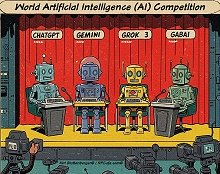Electronics & High Technology Components
- See Full List of AI Topics -
A secondary
battery, also known as a rechargeable battery or storage battery, is a type of electrochemical
cell that can be charged and discharged multiple times through reversible chemical
reactions. Unlike primary batteries, which are designed for single use and cannot
be recharged, secondary batteries are designed for multiple charge and discharge
cycles, making them a more sustainable and cost-effective choice in the long run.
Here are some key characteristics and advantages of secondary batteries:
Rechargeable: The primary advantage of secondary batteries is their ability to
be recharged. They can be connected to an external power source, such as a charger,
to replenish their energy and be reused multiple times.
Environmental Benefits: Secondary batteries are more environmentally friendly
compared to primary batteries because they reduce the number of disposable batteries
that end up in landfills. This helps reduce the environmental impact of battery
waste.
Cost-Efficient: While secondary batteries may have a higher upfront cost than
primary batteries, they can be more cost-effective in the long term because they
can be recharged and reused many times.
Variety of Chemistries: There are various types of secondary batteries, each
with its own chemistry and characteristics. Common types include lithium-ion (Li-ion),
nickel-metal hydride (NiMH), lead-acid, and nickel-cadmium (NiCd) batteries. These
batteries have different energy densities, discharge rates, and cycle life characteristics,
making them suitable for different applications.
Applications: Secondary batteries are used in a wide range of applications, including
portable electronics (e.g., laptops, smartphones, and digital cameras), electric
vehicles (EVs), renewable energy storage (e.g., solar power systems), uninterruptible
power supplies (UPS), and more.
Energy Storage: Secondary batteries play a crucial role in energy storage systems,
helping store excess energy generated from renewable sources like solar and wind
for use when needed.
Maintenance: Secondary batteries require some maintenance, such as periodic charging
and proper storage to maximize their lifespan and performance.
 This content was generated by primarily
the ChatGPT (OpenAI), and/or
Gemini (Google), and/or
Arya (GabAI), and/or
Grok 3 (x.AI) artificial intelligence (AI) engine.
Some review was performed to help detect and correct any inaccuracies; however,
you are encouraged to verify the information yourself if it will be used for critical
applications. In some cases, multiple solicitations to the AI engine(s) was(were) used to assimilate
final content. Images and external hyperlinks have also been added occasionally.
Courts have ruled that AI-generated content is not subject to copyright restrictions,
but since I modify them, everything here is protected by RF Cafe copyright. Many
of the images are likewise generated and modified. Your use of this data implies
an agreement to hold totally harmless Kirt Blattenberger, RF Cafe, and any and all
of its assigns. Thank you. Here are the major categories. This content was generated by primarily
the ChatGPT (OpenAI), and/or
Gemini (Google), and/or
Arya (GabAI), and/or
Grok 3 (x.AI) artificial intelligence (AI) engine.
Some review was performed to help detect and correct any inaccuracies; however,
you are encouraged to verify the information yourself if it will be used for critical
applications. In some cases, multiple solicitations to the AI engine(s) was(were) used to assimilate
final content. Images and external hyperlinks have also been added occasionally.
Courts have ruled that AI-generated content is not subject to copyright restrictions,
but since I modify them, everything here is protected by RF Cafe copyright. Many
of the images are likewise generated and modified. Your use of this data implies
an agreement to hold totally harmless Kirt Blattenberger, RF Cafe, and any and all
of its assigns. Thank you. Here are the major categories.
Electronics & High Tech
Companies | Electronics &
Tech Publications | Electronics &
Tech Pioneers | Electronics &
Tech Principles |
Tech Standards Groups &
Industry Associations | Societal
Influences on Technology
|









